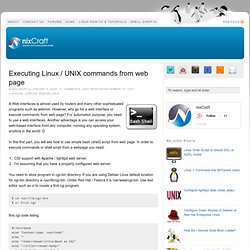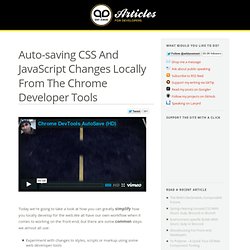

Tincr Chrome Extension. Executing Linux / UNIX commands from web page. A Web interfaces is almost used by routers and many other sophisticated programs such as webmin.

However, why go for a web interface or execute commands from web page? For automation purpose, you need to use a web interfaces. Another advantage is you can access your web-based interface from any computer, running any operating system, anytime in the world :D In this first part, you will see how to use simple bash (shell) script from web page. In order to execute commands or shell script from a webpage you need: CGI support with Apache / lighttpd web server.I'm assuming that you have a properly configured web server. You need to store program in cgi-bin directory. . $ cd /usr/lib/cgi-bin $ vi first.cgi first.cgi code listing: #! Save and close the file. . $ chmod +x first.cgi Fire up your web browser and test the script, for example type url or You need to send headers, first three lines are almost same for all your script: #!
Rest is html code. Echo "Today is $(date)" $(command) #! CGI Made Really Easy. Or, Writing CGI scripts to process Web forms Home > Web Technology Made Really Easy > CGI Made Really Easy Donate Go to Footnotes April 12, 2002-- The getcgivars() routines provided below have been updated to allow ";" as well as "&" for parameter separators.

If you're using an old version, please upgrade to the new one. Auf deutsch (in German), as translated by Friedemann WachsmuthEn español (in Spanish), as translated by René AlvarezEm português (in Portuguese), as translated by Clay ChagasIn het Nederlands (in Dutch), as translated by Simon Amstel So it's 4:00, your boss needs a CGI script written by 4:30, and you don't even know what CGI stands for. There's not much to it, despite any intimidating hype you might have heard. This primer focuses on writing CGI scripts to process HTML forms on the Web.
How to Save Changes on Inspecting an Element on Google Chrome. Auto-saving CSS And JavaScript Changes Locally From The Chrome Developer Tools. Today we're going to take a look at how you can greatly simplify how you locally develop for the web.We all have our own workflow when it comes to working on the front-end, but there are some common steps we almost all use: Experiment with changes to styles, scripts or markup using some web developer toolsGo back to a text editor to apply those changes and save themRefresh the browser to ensure our changes have been savedContinue debugging Whilst this workflow works fine, it can be made a lot easier thanks to a new extension for Google Chrome called the Chrome DevTools Autosave (by Nikita Vasilyev).

Chrome DevTools Autosave allows you to make live changes to local CSS and JavaScript files directly from inside the Chrome Developer Tools. Happy with that border-radius you've just tweaked in the browser? Satisfied with that minor JS fix you just tried out? How does it work? The extension itself relies on a local node server running (which we'll discuss shortly). Getting Setup Usage Pro-tips. Aptana.